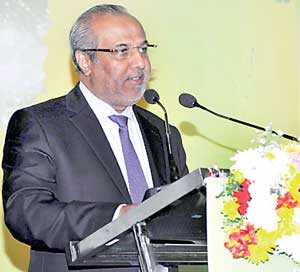Thursday Dec 18, 2025
Thursday Dec 18, 2025
Wednesday, 30 September 2015 00:04 - - {{hitsCtrl.values.hits}}



By Shanika Sriyananda
Sri Lankan policymakers need to be mindful of the risks and hazards in addressing urban development and infrastructure deficit to avoid hazard prone areas and also to avoid exposing communities to more risks, cautioned Rauff Hakeem, the Minister of City Planning and Water Supply.
Addressing the gathering at the release of the latest World Bank report - Leveraging Urbanization in South Asia: Managing Spatial Transformation for Prosperity and Liveability - held in Colombo, on Tuesday, he said that emphasis is being placed on the concept of critical infrastructure that underscores the importance of having higher-than-usual margins of safety while taking cognisance of the national disaster risk financing frameworks.
“ The report suggests developing this based on risk layering to match risks with appropriate financing instruments to help urban areas cope with disasters”, Minister Hakeem said adding the role of government is to create an enabling environment for the investors, entrepreneurs, architects and engineers to create vibrant infrastructure for the people.
He said that Colombo city alone still has over 50,000 families living in underserved settlements – slums and shanties and sustainable city development needs to entail alternative housing for the urban poor as they are the service providers for the city dwellers, the industrial hub and the ports. “Human security is a subject, quite surprisingly has been overlooked in the rush for development by not only us but also by the World Bank guiding principles”, Hakeem said.
Champika Ranawaka, the Minister of Megapolis and Western Region Development Champika Ranawaka said that the government has a long term vision of transforming Sri Lanka into a “smart country” with smart infrastructure, advanced technology, information technology and economic wealth.
“Urbanisation and urban development have key roles in developing the country. The entire world is moving towards an urbanised society. This is why the new ministry was created to transform the entire Western Province into the Megapolis area to usher comprehensive and development within the next five to six years,” he said.
“If managed well, urbanisation can lead to sustainable growth by increasing productivity and allowing innovation and new ideas to emerge,” said Ede Ijjasz-Vasquez, Senior Director, Social, Urban, Rural and Resilience Global Practice, World Bank.
“Better cities can help reduce vulnerability to poverty, improve living conditions, and create the environment for more and better paying jobs,” Ijjasz said, adding that in Sri Lanka, with nearly half of the population living in urban areas, urbanisation is higher than the official estimation.
Annette Dixon, Vice President for the South Asia Region of the World Bank, said policymakers in the region face a choice and continue with the same policies or undertake reforms to tap into the tremendous unrealized potential of South Asia’s cities.
“It is essential to move forward but it won’t be easy, but with the right policies and investments, South Asia’s cities can be much more liveable and prosperous,” Dixon said.
“A large share of Sri Lanka’s national population that is vulnerable to poverty lives in close proximity to the belt of urbanisation that links Kandy, Colombo, and Galle. Large numbers of vulnerable are also found in and around the major urban centres in the north and east of the country,” Francoise Clottes, World Bank Country Director for Sri Lanka and the Maldives, said.
She said that Sri Lanka has been experiencing a dynamic spatial transformation process driven by the Kandy-Colombo-Galle urbanisation belt as well as localised single-city agglomerations in the eastern and northern parts of the country, mainly around Trincomalee, Batticaloa, Akkaraipattu, and Jaffna.
The World Bank report - Leveraging Urbanisation in South Asia: Managing Spatial Transformation for Prosperity and Livability released yesterday states that South Asian countries, including Sri Lanka, can benefit from urbanisation as a major opportunity to transform their economies and join the ranks of richer nations.
Since it is difficult in dealing with the pressures that urban populations put on infrastructure, basic services, land, housing, and the environment have fostered, the report said that urbanisation in South Asia is ‘messy and hidden’. It states that this has contributed in constraining the region’s full realization of the prosperity and liveability benefits of urbanization.
According to the report’s findings, Sri Lanka has performed well relative to other countries in the region and its urbanisation has been less ‘messy’ in so far that only a relatively small proportion of the urban population lives in slums and it has largely eradicated extreme urban poverty.
Between 1999 and 2010, Sri Lanka was the country in the region with the fastest expansion of urban area, as measured using night-time lights data, relative to urban population. The rapid expansion of urban area relative to urban population reflects the sprawl and ribbon development that are characteristic of Sri Lanka’s urban development.
Since 2000, the report found, South Asia has made good strides in achieving greater prosperity with the increase in productivity linked with the growth of the region’s towns and cities. In Sri Lanka, this progress has also been linked with a decline in the share of the urban population living below the national poverty line from 7.9 percent in 2002 to 2.1 percent in 2013. Unlike many other countries in the region, the contribution made by manufacturing to Sri Lanka’s GDP continued to grow between 2000 and 2010.